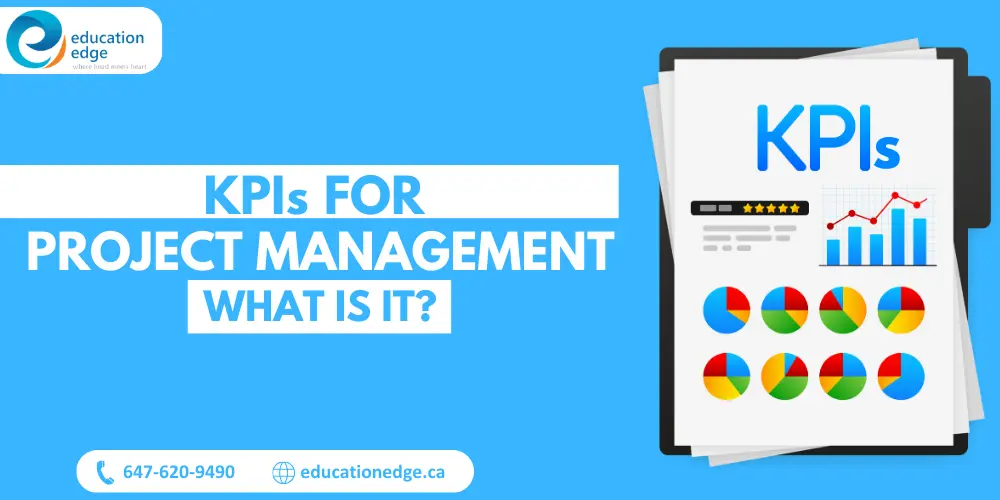
KPIs for Project Management are essential during a project. It is challenging to assess your progress toward your objectives in the absence of these. Hence, it provides a visible and quantitative framework that enables project managers to use their project management skills in order to make better decisions, simplify procedures, and ensure successful project outcomes.
Therefore, to know more about KPIs (Key Performance Indicators) for Project Management read this informative blog that will definitely help you. READ ON!
KPIs for Project Management
KPIs for Project Management stands for Key Performance Indicators, is a measurable metric that illustrates how well an organization or individual achieves essential business objectives.
However, KPIs differ according to the goals and industry, but it helps in evaluating performance and progress towards the desired results.
Types of KPIs for Project Management
There are the following types of KPIs for Project Management such as:
- Process KPIs
- Qualitative KPIs
- Quantitative KPIs
- Input KPIs
- Output KPIs
- Leading KPIs
- Lagging KPIs
- Outcome KPIs
Process KPIs:
Evaluate the effectiveness and effectiveness of particular business procedures to make sure they meet corporate objectives.
Qualitative KPIs:
It evaluate not statistical metrics like an opinion, staff engagement and client satisfaction to determine the overall situation and opinion of the company.
Quantitative KPIs:
It evaluates statistical metrics such as revenue, sales growth, and production output.
Input KPIs:
It evaluates the assets and invests or uses resources such as time, money and labor in order to achieve business results.
Output KPIs:
evaluate both the financial and non-financial outcomes of the business’s activities such as revenues.
Leading KPIs:
Monitor predictive signs that can affect positive results before they occur in order to predict future success.
Lagging KPIs:
Evaluate past performance, providing information on past achievements or areas in need of development.
Outcome KPIs:
Measure the final outcomes and impact of actions implemented in relation to overall business goals and objectives.
Qualities of Good KPIs
Effective KPIs have various qualities that make them essential and performance improvement tools.
Hence, here are the qualities of good KPIs:
- KPI must be developed by the management of the organization
- A good KPI must be connected with the organization objectives
- KPIs should be easy to understand by all stakeholders
- Key Success Factors (KSFs) alter only when corporate objectives change fundamentally.
- Key Performance Indicators (KPIs) vary as goals are met or as management’s attention moves.
How to Define the Key Performance Indicators
To effectively define key performance indicators, you must consider these points:
- Start by determining your specific aim. Key performance indicators (KPIs) should be relevant to strategic objectives.
- Determine the reasons for the organization’s success or failure.
- Consider both short- and long-term objectives while developing KPIs.
- Take stakeholder needs into consideration when identifying KPIs.
- For an accurate evaluation, use both qualitative and quantitative measures.
- Choose relevant performance indicators and metrics.
- Set goals and track progress against those objectives on a regular basis.
Example of KPI for Project Management
There are several KPI kinds in the project management industry, which include:
- The number of outstanding issues
- Current resource distribution
- Estimated time to completion of the project
- Labour expenses (per month)
- Issues discovered during code review
- QA discovered flaws Customer discovered problems
- Timeline for the project (Agile or Waterfall)
- Backlog of current development
If you’re looking to improve how you track and manage project success using KPIs, our PMP Certification course provides the essential skills and knowledge to excel.
5 KPIs for Project Manager
Here are the 5 Key Performance Indicators (KPIs) for project manager:
1. Cost Performance Index
The Cost Performance Index is a measure of a project’s cost efficiency. It is determined by taking the Earned Value (EV) and dividing it by the Actual Cost (AC).
- A CPI value greater than 1 means the project is underperformance
- A value less than 1 indicates that it is performing better than expected
- Equal to 1 indicates performance is on target
CPI Formula:
| C.P.I. = E.V./ A.C. |
2. Budget Variance
Budget variance is the difference between the budgeted and actual cost of work done. Hence, the B.V outcomes are as follows:
- A positive result denotes that the project is under budget
- A result of zero suggests that the project is on budget
- A negative result signifies that the project surpasses the budget
Budget Variance Formula
| BV/CV = E.V. – A.V. |
Where BV means Budget Variance, and CV means Cost Variance
3. Planned Value
P.V. (Planned Value) is an important component of the cost management strategy because it aims to establish a consistent financial performance standard against specified project milestones.
Planned Value Formula
| P.V. = B.A.C. X Planned percentage complete |
Where B.A.C means Budget at completion
4. Billable Utilization
Billable Utilization compares the amount of time a team member spends on billable (client-chargeable) work to the total available working hours.
Therefore, it is an important measure for service-oriented initiatives where billable hours are used to generate income.
Billable Utilization
| Billable utilization = (Number of billable hours / Number of available hours)X 100% |
5. Schedule Performance Index
The Schedule Performance Index is a measure of a project’s schedule efficiency. It is calculated by taking the Earned Value (EV) and dividing it by the Planned Value (PV).
- SPI value greater than 1 indicates that the project is on track
- Value less than 1 indicates that it is behind schedule
SPI Formula
| S.P.I. = E.V. / P.V. |
Frequently Asked Questions
1. What do KPIs stand for?
ANS: KPIs stand for Key Performance Indicators.
2. What are KPIs for Project Management?
ANS: KPIs for Project Management are measurable metrics that show how successfully a project achieves its goals.
3. How do you select appropriate KPIs for a project?
ANS: Relevant KPIs are selected based on project objectives, stakeholder expectations, and essential success determinants.
4. Name the types of KPIs?
ANS: The types of KPIs are:
Process KPIs
Qualitative KPIs
Quantitative KPIs
Input KPIs
Output KPIs
Leading KPIs
Lagging KPIs
Outcome KPIs







